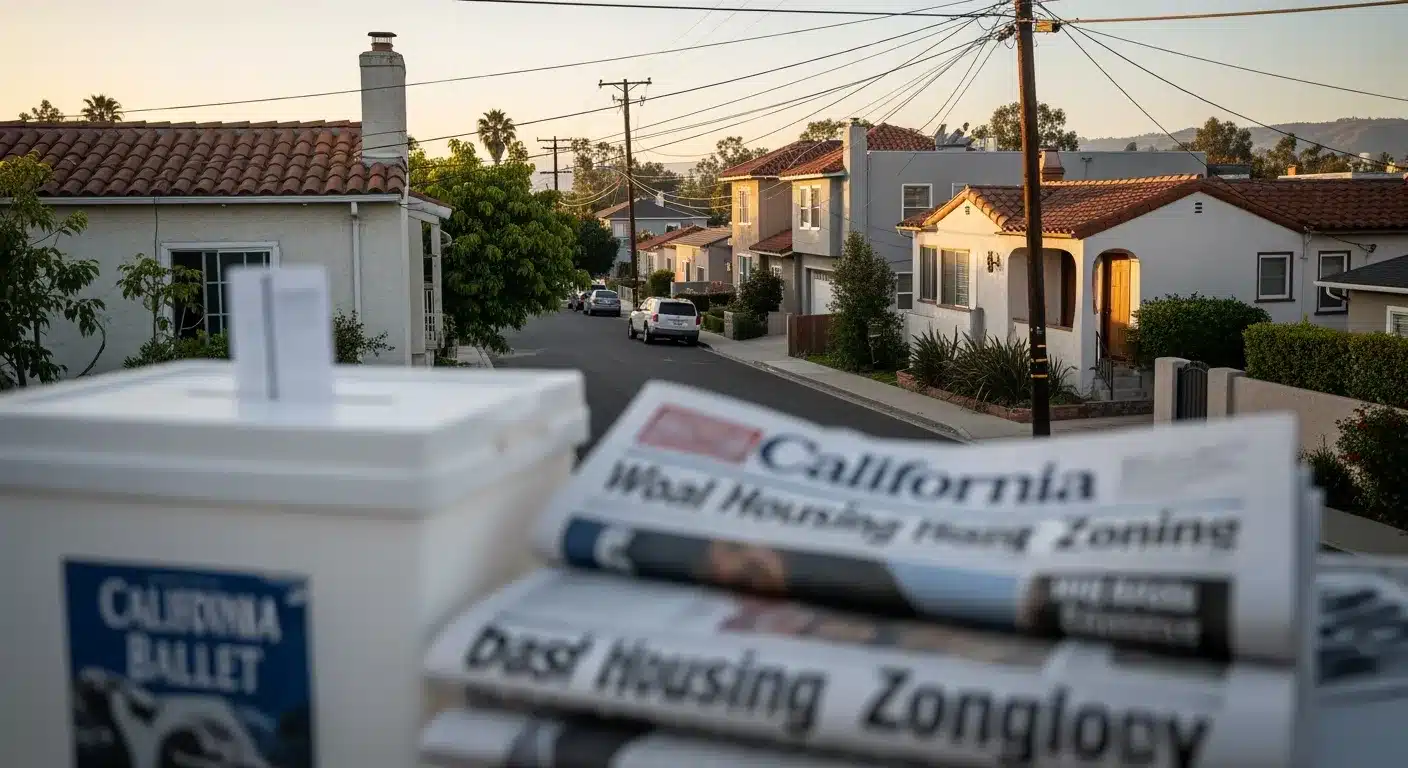
This post was last modified on August 15, 2025.
Local ballot measures are playing a significant role in shaping California’s housing environment, often in unexpected ways. You might notice that while some initiatives aim to facilitate affordable housing development, others impose restrictions that complicate zoning changes. This duality reflects community priorities that can either promote growth or stifle it. Understanding these nuances is important to grasping the broader implications for housing availability and affordability across the state. What factors are driving these trends?
Proposition 5: Lowering Voter Thresholds for Housing Bonds
Although Proposition 5 aimed to lower the voter approval threshold for local general obligation bonds from two-thirds to 55%, its defeat in the November 2024 election highlights the complexities surrounding housing funding in California.
The proposal sought to enhance bond funding for affordable housing and public infrastructure projects, which could have produced significant economic benefits. With an estimated 1,500 new housing units per $100 million in bonds, it promised reduced housing costs and increased job creation.
However, concerns about escalating local debt and vague definitions of “infrastructure” dampened voter engagement. Ultimately, the rejection of Proposition 5 underscores the challenges in securing necessary funding for housing solutions while balancing fiscal responsibility amidst public apprehensions. Additionally, understanding the property tax appeal process can help local governments manage their budgets more effectively, potentially influencing future housing initiatives.
Local Measures and Their Impact on Housing Development
As local measures increasingly shape housing development in California, their impact on supply and affordability can’t be overlooked.
About 22% of these measures impose urban growth boundaries, effectively limiting expansion and inadvertently worsening supply shortages. Additionally, 15% require voter approval for zoning changes, creating hurdles that slow down development timelines.
While some measures aim to encourage housing production through streamlined processes and development incentives, they remain in the minority.
Without strong community engagement and a shift towards more flexible zoning, many localities may struggle to meet state housing goals. Ultimately, these restrictive measures can hinder the creation of affordable housing, exacerbating the very crises they aim to address. Moreover, high HOA fees can further complicate housing affordability and deter potential buyers from entering the market.
Tenant Protections and the Future of Rent Control
Local measures greatly influence housing development, but tenant protections are equally vital in shaping the rental environment in California.
The Tenant Protection Act (AB 1482) established statewide rent stabilization, capping rent increases to 5% plus local inflation, or 10%, whichever is lower. This law, alongside regional variations, reflects tenant advocacy efforts to secure fair housing practices.
While proposals like AB 1157 aim to tighten these caps further, they face significant pushback from landlord groups concerned about investment impacts. Limited rent increases can diminish landlords’ incentives to maintain properties, potentially affecting the quality of rental housing.
Upcoming changes, such as increased tenant response time and credit reporting options, enhance tenant rights and responsibilities.
As you navigate these evolving regulations, understanding the complexities of local protections will be imperative in the fight for equitable housing.
Enhanced Local Authority Through Direct Democracy
Empowering communities through direct democracy allows voters to take charge of housing priorities, which is key in addressing the ongoing housing crisis in California.
By lowering voter thresholds for housing measures, like Proposition 5, you’re increasing ballot accessibility, enabling local governments to propose funding initiatives with a greater chance of approval.
This shift enhances community engagement, allowing residents to directly influence zoning changes and the establishment of affordable housing trust funds.
As local voters approve measures that increase density limits and streamline development, they bypass legislative gridlock.
Ultimately, these empowered decisions can lead to billions in funding, helping to create and preserve affordable housing, and ensuring local priorities align with pressing housing needs.
Voter Trends and Support for Housing Initiatives
How do voter trends reflect the shifting terrain of support for housing initiatives in California? Voter demographics play a significant role in shaping outcomes. Higher turnout in general elections often leads to broader representation, while low participation in off-cycle elections can skew perspectives on housing measures.
As housing awareness grows amid the affordability crisis, voters increasingly engage with ballot initiatives. Recent support for funding measures, like the $300 million bond in San Francisco, showcases this trend.
However, divided opinions remain, as seen with Proposition 1, indicating mixed sentiments. Urban areas typically favor housing reforms, while skepticism persists in suburban regions.
Frequently Asked Questions
How Can I Learn About Upcoming Local Housing Ballot Measures?
To learn about upcoming local housing ballot measures, check your local government’s election website, review voter guides, follow housing advocacy groups, and attend public forums for detailed insights on housing policies affecting your community.
What Is the Timeline for Implementing Proposition 5 Changes?
The implementation timeline for Proposition 5 begins in early 2025, following the November 2024 election results. Local governments will then issue bonds with 55% voter approval, establishing oversight committees and initiating audits for accountability.
How Do These Measures Affect Property Values in My Area?
These measures significantly influence property values in your area by creating market fluctuations. Trends like tax breaks for older homeowners or restrictions on housing supply can lead to rising property prices, affecting affordability and investment potential.
Are There Any Specific Eligibility Criteria for Bond Funding?
To qualify for bond funding, you must meet specific eligibility criteria, including having a project awarded by HCD since 2018, demonstrating complete financing, and ensuring at least 20% of units serve low-income families.
What Are the Potential Risks of Local Ballot Measures for Housing?
Local ballot measures pose risks, including community opposition that complicates housing development. A thorough risk analysis reveals potential delays, increased costs, and limitations on affordable housing, ultimately exacerbating housing shortages and affordability issues in your community.




